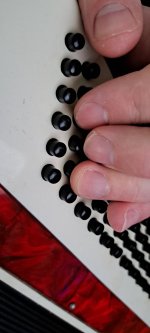Technical
Member
Hi,
I'm a beginner who just wants some third party perspectives and opnions on bass technique. I've had a lesson recently and the teacher corrected my technique but I'm struggling with it.
I use 4th finger for bass row and 3rd finger for major row but have been told I should use my second finger for all rows beyond that (I just used my 3rd), something to do with freeing up a finger for alternating bass. I've been told my fingers should be at an angle and not vertical inline and this is why I struggle with putting my 4th and 3rd finger on bass and major at the same time (I currently just press both with my 4th fingers). I've also been told that I should open and close the bellows like a book, which I know from my own research but the problem with all these suggestions is I struggle to physically do them.
I think part of the problem is my thick fingers (UK ring size Z+2/3) but possibly also my lack of suppleness. I can just about press minor with my second finger if I bend my hand up instead of just having it palm flat aghainst the side but as the bellows go out and the angle increases it makes it less possible for my hand/wrist to follow. I'm just not sure how I open my bellows down and still physically follow it with my band in a way where I can play the bass buttons. I also just can't physically get my 4th and 2nd finger to come close enough together in certain positions to play bass and minor.
I assumed that people had their palm flat against the instrument so do you get that angle on the fingers purely from bending them slighting differently? I struggle to do these positions without bending my hand up and of course this makes things more difficult when playing bass notes of a decent distance apart. Maybe part of the solution is doing stretches? Should I be moving my 4th out of the way for my 2nd to play? I'm hoping I'm just missing a piece of the puzzle which will make it all work, I can't be the only one with thick fingers.
Any insights would be welcome.
I'm a beginner who just wants some third party perspectives and opnions on bass technique. I've had a lesson recently and the teacher corrected my technique but I'm struggling with it.
I use 4th finger for bass row and 3rd finger for major row but have been told I should use my second finger for all rows beyond that (I just used my 3rd), something to do with freeing up a finger for alternating bass. I've been told my fingers should be at an angle and not vertical inline and this is why I struggle with putting my 4th and 3rd finger on bass and major at the same time (I currently just press both with my 4th fingers). I've also been told that I should open and close the bellows like a book, which I know from my own research but the problem with all these suggestions is I struggle to physically do them.
I think part of the problem is my thick fingers (UK ring size Z+2/3) but possibly also my lack of suppleness. I can just about press minor with my second finger if I bend my hand up instead of just having it palm flat aghainst the side but as the bellows go out and the angle increases it makes it less possible for my hand/wrist to follow. I'm just not sure how I open my bellows down and still physically follow it with my band in a way where I can play the bass buttons. I also just can't physically get my 4th and 2nd finger to come close enough together in certain positions to play bass and minor.
I assumed that people had their palm flat against the instrument so do you get that angle on the fingers purely from bending them slighting differently? I struggle to do these positions without bending my hand up and of course this makes things more difficult when playing bass notes of a decent distance apart. Maybe part of the solution is doing stretches? Should I be moving my 4th out of the way for my 2nd to play? I'm hoping I'm just missing a piece of the puzzle which will make it all work, I can't be the only one with thick fingers.
Any insights would be welcome.

